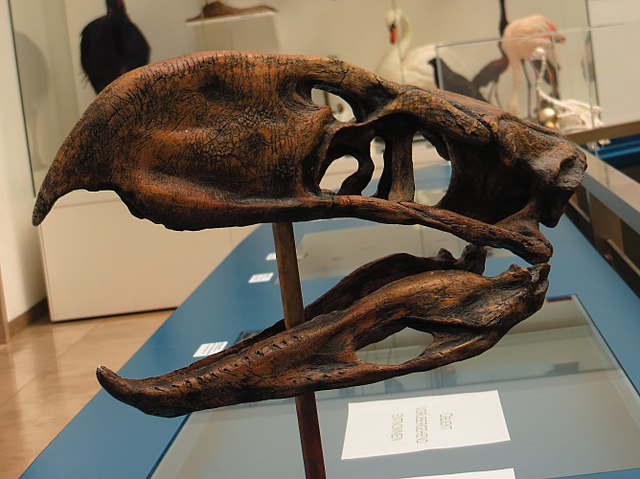Phorusrhacos, commonly known as the “terror bird,” was an apex predator that roamed South America during the Miocene epoch, approximately 23 to 2.5 million years ago. Here’s a closer look at this fascinating bird:
1. Taxonomy and Evolution:
- Family: Phorusrhacos belonged to the family Phorusrhacidae, a group of flightless birds also known as “terror birds.”
- Evolutionary Lineage: These birds evolved in isolation in South America, filling the niche of large terrestrial predators after the extinction of the dinosaurs.

2. Physical Characteristics:
- Size: Phorusrhacos was a large bird, with species ranging in height from about 6 to 10 feet (1.8 to 3 meters).
- Long Legs: It had long, powerful legs adapted for running.
- Reduced Wings: Phorusrhacos had small, vestigial wings that were incapable of flight.
3. Beak and Feeding Behavior:
- Large Beak: One of the most distinctive features of Phorusrhacos was its large, hooked beak.
- Carnivorous Diet: The structure of its beak suggests that Phorusrhacos was a carnivorous predator, likely preying on small to medium-sized mammals.
4. Binocular Vision:
- Forward-Facing Eyes: Phorusrhacos had forward-facing eyes, providing binocular vision.
- Depth Perception: This adaptation is indicative of a predator with depth perception, useful for hunting and capturing prey.
5. Terrestrial Lifestyle:
- Flightlessness: The inability to fly suggests that Phorusrhacos was adapted to a fully terrestrial lifestyle.
- Swift Runner: Its long legs and lightweight build made it a potentially swift and agile runner.
6. Habitat and Distribution:
- South American Range: Phorusrhacos inhabited the open grasslands and forests of South America.
- Fossil Finds: Fossils of Phorusrhacos have been discovered in Argentina and other parts of South America.
7. Ecosystem Interactions:
- Apex Predator: As an apex predator, Phorusrhacos likely played a crucial role in regulating the populations of smaller mammals in its ecosystem.
- Coexistence with Other Megafauna: It lived alongside other megafauna of the Miocene, including giant ground sloths and various herbivorous mammals.
8. Extinction:
- Pleistocene Transition: Phorusrhacos and other large terrestrial birds went extinct around the Pleistocene transition, possibly due to environmental changes and the arrival of new mammalian competitors.
- Giant Ground Sloths: The extinction of large herbivores like giant ground sloths, which were prey for terror birds, might have also played a role in their decline.
9. Scientific Significance:
- Evolutionary Experiment: The evolution of flightless, predatory birds like Phorusrhacos represents an interesting experiment in the evolutionary history of birds.
- Isolation in South America: The unique fauna of South America, including terror birds, highlights the effects of the continent’s long isolation from other landmasses.
Phorusrhacos, with its imposing size and predatory adaptations, stands out as one of the remarkable creatures of the Miocene epoch. The study of terror birds like Phorusrhacos provides insights into the dynamics of prehistoric ecosystems and the evolutionary pathways taken by large, flightless birds in South America.











